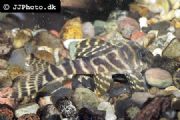
Fish delivered straight to your door from Wildwoods
Hundreds of Species available today…
TFF Mailing List
Join the TFF mailing list today and we will email you with latest offers, news items and more.
L173(Hypancistrus zebra, Zebra Plec, Imperial Plec)
An unimstakeable catfish with a bold pattern of dark stripes against an almost pure white background. The stripes on the head run near-vertically, while those on the body are approximately horizontal. L046/L173 is the standard form, L098 a form with wavy stripes instead of straight stripes.
One of the most popular L-number catfish in the aquarium hobby, this species was over-collected during the 1990s and became rather rare in the wild. Consequently, exports of wild-caught fish were banned, and all fishes seen in aquarium stores currently are tank-bred.
The zebra plec inhabits rocky areas in fast-flowing rivers, and normally stays close to the substrate in deep water. In the aquarium it should be provided with plenty of rocky hiding caves and crevices but leave some open sandy areas for foraging in. Plants are irrelevant to this species, and bogwood does not seem to be important either (but supply some as source of dietary fibre is a good idea, as with any plec).
Fish information (behaviour and breeding):
A distinctly carnivorous species this catfish needs to be provided with a varied diet consisting of bloodworms, mosquito larvae, and small crustaceans. Being rather a slow and shy feeder, it is not wise to mix this species with more aggressive feeders such as loaches, and ideally it should be kept only with species that forage in the middle and upper layers of the aquarium, such as tetras.
In terms of social behaviour this catfish is tolerant of conspecifics though it is best kept in a 'harem' group consisting of one male to multiple females. Do not mix with larger or more aggressive plecs (or territorial catfish and cichlids). Breeding is frequently reported in home aquaria. Soft and acidic water is preferred, but spawning has taken place in hard and alkaline water as well. Males have pectoral fin spines that bear long, sturdy bristles while the females have much less bristly fins. Spawning occurs inside a suitable burrow or cave, and the male guards the eggs. Once free swimming (about three days after hatching) the fry will immediately take dried foods and brine shrimp nauplii. Juveniles are more frequently sold than adults, and when very young (around 2-4 cm long) need proportionally small foods to do well. Shaved frozen bloodworms seem to work well.
| Family Group: | L Numbers |
| Distribution | Brazil, Rio Xingú |
| Temperature | 26-30C |
| Size | Up to 8 cm |
| Water Parameters | Adaptable, but providing lots of oxygen is essential |
| Water PH | 6.0-7.5 |
Useful sources of information:
DATZ are the original source of L number information.
Other information on L numbers can be found from the book All L Numbers published by Aqualog.
On the web, a comprehensive source of information on L Numbers and catfish can be found at www.planetcatfish.com and also www.scotcat.com
Shop stock
The latest shops to have this fish in stock are listed below. Click on a shop name for full shop details, or click the link below the shops to view ALL shops that stock this fish.
No shops currently have any stock of this fish
Other fish added to TFF recently:
Other fish added to TFF/TF2YD recently can be viewed below.
| Scientific Name | Common Name | ||
| Pseudacanthicus pitanga L024 | L24, Red Fin Cactus Pleco | ||
| Paraneetroplus synspilus | Red Head Quetzel Cichlid | ||
| Piaractus brachypomus | Red Belly Pacu | ||
| Astronotus Ocellatus 'yellow' | Lemon Yellow Oscar | ||
| Cichlasoma sp. HYBRID | Flowerhorn Cichlid 'Short Body Super Red Dragon' |







